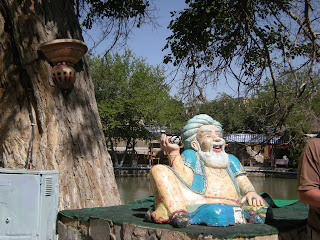After breakfast, we headed out to see historic Bokhara, which is effectively an open air museum. However in every niche and archway, there is a merchant selling something. Since Bokhara was noted for its mercantile past, I really didn’t have a problem with it. For the most part, the merchants didn’t follow you although some of the children would follow after you trying to sell post cards or similar items. The first complex that we went to see was the LABIHAUS (SP?), which means that it was near water. The complex was built in the 16th - 17th Century and included two Madrassahs which was in its day the largest in Central Asia. Local artisans included local elements which included Zorastrian Sun symbols. In the park area was a statue of Hoja sin Afandi (sp?) who is an important figure in Turkic literature. In addition to the Madrassahs, there was a Hanichka, which is sort of a monastery or dwelling place for wandering dervishes. Caravanserai’s were also constructed in the area.
 Labihouse (sp?) Complex - Built 16th - 17th Century
Labihouse (sp?) Complex - Built 16th - 17th Century Description
Description Madrassah
Madrassah Madrassah
Madrassah Hoja sin Afandi - Important Figure in Turkic Literature
Hoja sin Afandi - Important Figure in Turkic Literature Figures in Park
Figures in Park Meeting the Camel Driver
Meeting the Camel Driver Hoja Figure
Hoja Figure Description
Description Description
Description Magnificent Painted work
Magnificent Painted work Inside courtyard of Ancient Madrassah
Inside courtyard of Ancient MadrassahBokhara originally had three trading domes. Two have fallen into complete ruin. The trading domes were usually where two major roads intersected. The first one that we went to was the one involved in changing money. This was considered to be unlucky so this niche was left to the Jewish population of Bokhara. There was another one that involved the sale of hats. The third involves gold jewelry and in a way still functions. Carpets were never really made in Bokhara. They were imported from what is now Turkmenistan and other surrounding countries.
 View down the Street
View down the Street Description
Description Remains of Tile Work
Remains of Tile Work Door into Mosque
Door into Mosque Dome down the street
Dome down the street Hotel where we are staying
Hotel where we are staying Description
Description Me in front of Bazaar
Me in front of Bazaar Street in Bazaar
Street in BazaarThe Uleg Madrassah was built in the 15th Century and the one opposite was built two centures later. Both of these Madrassahs functioned until the 20th Century when they were probably shut down by the Communist Party.
The famous tower was built in the twelfth century and was the one building that Genghis Khan did not destroy. It is 47 meters tall. It was built of kiln fired bricks and the design was created by laying the bricks in different patterns as they went up. This tower was the highest in the area and was used as a beacon in the surrounding desert.
 Oldest Tower in Bokhara
Oldest Tower in Bokhara Madrassah
Madrassah View
View Description
Description Restoration in Progress
Restoration in Progress Restoration in Progress
Restoration in Progress Remains
Remains Madrassah
Madrassah Other Gateway
Other Gateway Various small shops
Various small shops She sold me teapot for Micah's Mother
She sold me teapot for Micah's Mother Tower left standing by Genghis Khan
Tower left standing by Genghis Khan Mosque
Mosque Note Arabic script on Tower
Note Arabic script on Tower Mosque
Mosque Magnificent painting in Mosque
Magnificent painting in Mosque De'ora Making a Movie - Tajik Girl
De'ora Making a Movie - Tajik Girl Description
Description Description
Description Description
Description Description
Description Description
Description In Working Madrassah
In Working Madrassah More Shops
More Shops Description
Description Mosque of 40 Columns
Mosque of 40 Columns Ceiling
Ceiling Official Name of Mosque
Official Name of Mosque Minaret at Mosque of 40 Columns
Minaret at Mosque of 40 Columns Entrance
EntranceWe visited the Mosque across from the Ark which is known as the Mosque with 40 columns. It actually has 20 columns, which were reflected in the pool in front of the Mosque. We went through the park and across the street to the Ark, which is a massive building. The ark was built on a hill which is 20 meters higher than the surrounding area and the walls are another 20 meters high. It is a very impressive building. We went to the coronation hall, which is open to the sky since Bokhara and about 300 sunny days a year. Our next stop was at the Chor Minor Mosque built in the 19th Century.
 Ark
Ark Description
Description In Coronation Room in Ark
In Coronation Room in Ark Coronation Room in Ark
Coronation Room in Ark
Directions

Chor Minor - 19th Century Mosque
 Chor Minor Mosque
Chor Minor Mosque Note Restoration Date of 1968
Note Restoration Date of 1968 Description
Description View from where we had dinner
View from where we had dinner Another View from Restaurant
Another View from RestaurantWe visited the Mosque across from the Ark which is known as the Mosque with 40 columns. It actually has 20 columns, which were reflected in the pool in front of the Mosque. We went through the park and across the street to the Ark, which is a massive building. The ark was built on a hill which is 20 meters higher than the surrounding area and the walls are another 20 meters high. It is a very impressive building. We went to the coronation hall, which is open to the sky since Bokhara and about 300 sunny days a year. Our next stop was at the Chor Minor Mosque built in the 19th Century.